 BMW R 1250 RT - Owner's Manual > Refuelling
BMW R 1250 RT - Owner's Manual > Refuelling
Fuel grade
Requirement
To ensure optimal fuel consumption, fuel should be sulphur-free or as low-sulphur as possible.
ATTENTION Engine operation with leaded fuel
Damage to catalytic converter
- Do not attempt to run the vehicle on leaded fuel or fuel with metallic additives (e.g. manganese or iron).
- Observe the maximum ethanol content of the fuel.
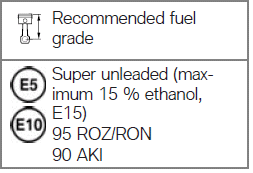
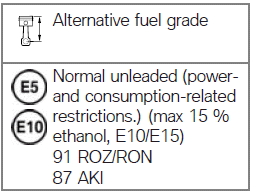
- Pay attention to the following symbols in the fuel filler cap and on the fuel pump:

- After refuelling with fuels of poor-quality, sporadic knocking noises may be perceptible.
Refuelling
WARNING Fuel is highly flammable
Risk of fire and explosion
- Do not smoke. Never bring a naked flame near the fuel tank.
WARNING Escape of fuel due to heatinduced expansion if fuel tank is overfilled
Risk of falling
- Do not overfill the fuel tank.
ATTENTION Wetting of plastic surfaces by fuel
Damage to the surfaces (surfaces become unsightly or dull)
- Clean plastic surfaces immediately after contact with fuel.
- Make sure the ground is level and firm and place the motorcycle on its centre stand.
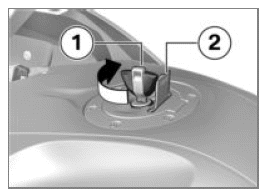
- Open the protective cap 2.
- Unlock the fuel tank cap by turning the ignition key 1 clockwise and open up.
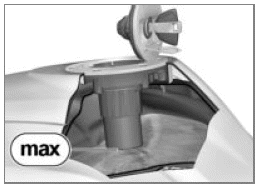
- Refuel with fuel up to the lower edge of the filler neck.
NOTICE When refuelling after running on reserve, make sure that you top up the tank to a level above reserve, so that the new level is detected and the fuel reserve indicator light is switched off.
NOTICE The "usable fuel capacity" specified in the technical data is the quantity that the fuel tank could hold if refilled after it had been run dry and the engine had cut out due to a lack of fuel.
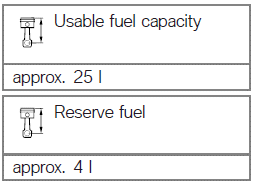
- Press the fuel tank cap down firmly to close.
- Remove the ignition key and close the protective cap.
Refuelling
- with Keyless Ride OE
Requirement
The steering lock is disengaged.
WARNING Fuel is highly flammable
Risk of fire and explosion
- Do not smoke. Never bring a naked flame near the fuel tank.
WARNING Escape of fuel due to heatinduced expansion if fuel tank is overfilled
Risk of falling
- Do not overfill the fuel tank.
ATTENTION Wetting of plastic surfaces by fuel
Damage to the surfaces (surfaces become unsightly or dull)
- Clean plastic surfaces immediately after contact with fuel.
- Make sure the ground is level and firm and place the motorcycle on its centre stand.
- with Keyless Ride OE
- Switching off ignition
NOTICE The fuel filler cap can be opened within the defined waiting time after the ignition has been switched off, without the radio-operated key being within range.

- There are two variant ways of opening the fuel filler cap:
- Within the after-running period.
- After the after-running period has expired.
Version 1
- with Keyless Ride OE
Requirement
Within the waiting time
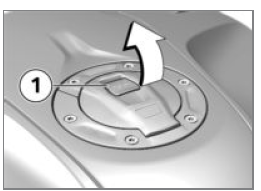
- Slowly pull tab 1 on the fuel filler cap up.
- Fuel filler cap unlocks.
- Fully open the fuel filler cap.
Version 2
- with Keyless Ride OE
Requirement
After the waiting time has expired
- Bring the radio-operated key into range.
- Slowly pull tab 1 up.
- The telltale light for the radio-operated key flashes while the search for the radio-operated key is in progress.
- Again slowly pull up tab 1 of the fuel filler cap.
- Fuel filler cap unlocks.
- Fully open the fuel filler cap.
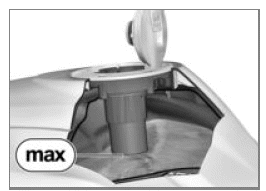
- Refuel with fuel of the grade stated above; do not fill the tank past the bottom edge of the filler neck.
NOTICE When refuelling after running on reserve, make sure that you top up the tank to a level above reserve, so that the new level is detected and the fuel reserve indicator light is switched off.
NOTICE The "usable fuel capacity" specified in the technical data is the quantity that the fuel tank could hold if refilled after it had been run dry and the engine had cut out due to a lack of fuel.
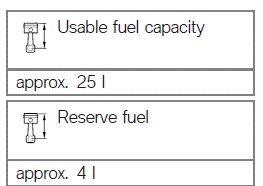
- Press down firmly on the filler cap of the fuel tank.
- The fuel filler cap engages with an audible click.
- The fuel filler cap locks automatically when the waiting time expires.
- The engaged fuel filler cap locks immediately when you secure the steering lock or switch on the ignition.
Securing motorcycle for transportation
- Make sure that all components that might come into contact with straps used to secure the motorcycle are adequately protected against scratching. Use adhesive tape or soft cloths, for example, for this purpose.
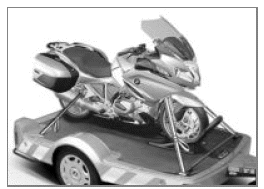
ATTENTION Vehicle topples to side when being lifted on to stand
Risk of damage to parts if vehicle topples
- Secure the vehicle to prevent it toppling, preferably with the assistance of a second person.
- Push the motorcycle onto the transportation flat and hold it in position: do not place it on the side stand or centre stand.
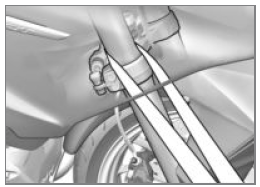
ATTENTION Trapping of components
Component damage
- Do not trap components such as brake lines or cable legs.
- Guide left and right tensioning straps through the fork bridge and tension at the bottom.
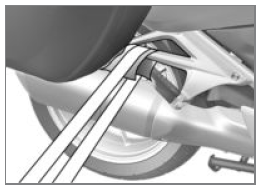
- Secure the tensioning straps behind on both sides on the bracket for the rear footrest and tighten.
- Tension all tensioning straps evenly so that the motorcycle is securely fastened.
See also:
 BMW R 1250 RT - Owner's Manual > Brakes
BMW R 1250 RT - Owner's Manual > Brakes
How can stopping distance be minimised? Each time the brakes are applied, a load distribution shift takes place with the load shifting forward from the rear to the front wheel. The sharper the motorcycle decelerates, the more load is shifted to the front wheel. The higher the wheel load, the more braking force can be transmitted without the wheel locking.
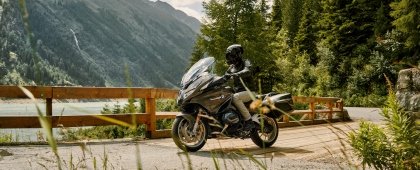 BMW R 1250 RT
BMW R 1250 RT Kymco Agility 50
Kymco Agility 50 Piaggio Liberty 50
Piaggio Liberty 50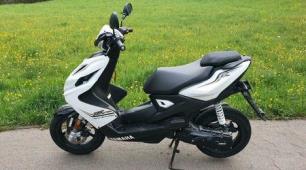 Yamaha aerox NS50
Yamaha aerox NS50 Aprilia SR50R
Aprilia SR50R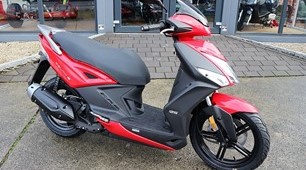 Kymco Agility 50
Kymco Agility 50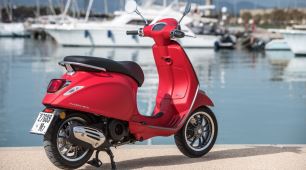 Vespa Primavera 50
Vespa Primavera 50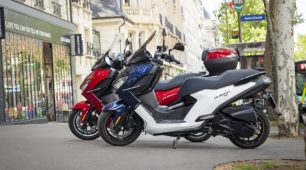 Peugeot Speedfight
Peugeot Speedfight